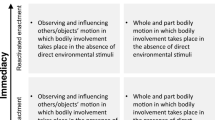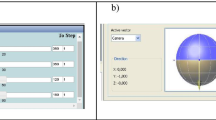Abstract
This paper examines the relation between bodily actions, artifact-mediated activities, and semiotic processes that students experience while producing and interpreting graphs of two-dimensional motion in the plane. We designed a technology-based setting that enabled students to engage in embodied semiotic activities and experience two modes of interaction: 2D freehand motion and 2D synthesized motion, designed by the composition of single variable function graphs. Our theoretical framework combines two perspectives: the embodied approach to the nature of mathematical thinking and the Vygotskian notion of semiotic mediation. The article describes in detail the actions, gestures, graph drawings, and verbal discourse of one pair of high school students and analyzes the social semiotic processes they experienced. Our analysis shows how the computerized artifacts and the students’ gestures served as means of semiotic mediation. Specifically, they supported the interpretation and the production of motion graphs; they mediated the transition between an individual’s meaning of mathematical signs and culturally accepted mathematical meaning; and they enable linking bodily actions with formal signs.





Similar content being viewed by others
References
Ainsworth, S. E. (1999). Designing Effective Multi-representational Learning Environments (report number 58), ESRC Centre for Research in Development, Instruction and Training, University of Nottingham, technical.
Alibali, M. W., Kita, S., & Young, A. J. (2000). Gesture and the process of speech production: we think, therefore we gesture. Language and Cognitive Processes, 15, 593–613. doi:10.1080/016909600750040571.
Bartolini Bussi, M., Chiappini, G., Paola, D., Reggiani, M., & Robutti, O. (2004). Teaching and learning mathematics with tools. In L. Cannizzaro, A. Pesci, & O. Robutti (Eds.), Research and Teacher Training in Mathematics Education in Italy: 2000–2003 (pp. 138–169). Milano: Ghisetti e Corvi Editori.
Beichner, R. (1994). Testing student interpretation of kinematics graphs. American Journal of Physics, 62, 750–762. doi:10.1119/1.17449.
Borba, M. C., & Confrey, J. (1996). A students’ construction of transformations of functions in a multi-representational environment. Educational Studies in Mathematics, 31(3), 319–337. doi:10.1007/BF00376325.
Botzer, G., & Yerushalmy, M. (2006). Interpreting motion graphs through metaphorical projection of embodied experience. International Journal of Technology in Mathematics Education, 13(3), 127–138.
Ernst, P. (2006). A semiotic perspective of mathematical activity: The case of number. Educational Studies in Mathematics, 61(1–2), 67–101. doi:10.1007/s10649-006-6423-7.
Falcade, R., Laborde, C., & Mariotti, M. A. (2007). Approaching functions: Cabri tools as instruments of semiotic mediation. Educational Studies in Mathematics, 66, 317–333. doi:10.1007/s10649-006-9072-y.
Friedler, Y., Nachmias, R., & Linn, M. C. (1990). Learning scientific reasoning skills in microcomputer-based laboratories. Journal of Research in Science Teaching, 27(2), 173–191. doi:10.1002/tea.3660270208.
Gibbs, R. W. (2006). Embodiment and cognitive science. New York: Cambridge University Press.
Goldin, G. A. (2002). Representation in mathematical learning and problem solving. In L. D. English, M. G. Bartolini Bussi, G. A. Jones, R. A. Lesh & D. Tirosh (Eds.), Handbook of International Research in Mathematics Education (pp. 197–218). Mahwah, NJ: Lawrence Erlbaum Associates.
Goldin-Meadow, S. (2003). Hearing gestures: How our hands help us think. Cambridge, MA: Belknap.
Janvier, C. (Ed.). (1987). Problems of representation in the teaching and learning of mathematics. Hillsdale, NJ: Lawrence Erlbaum Associates.
Kaput, J. J., & Roschelle, J. (1997). Deepening the impact of technology beyond assistance with traditional formalisms in order to democratize access to ideas underlying calculus. In E. Pehkonen (Ed.), Proceedings of the 21st Conference of the International Group for the Psychology of Mathematics Education (Vol. 1, pp. 105–112). Finland: Lahti.
Lakoff, G., & Nunez, R. E. (2000). Where mathematics comes from. How the embodied mind brings mathematics into being. New York: Basic Books.
McDermott, L. C., Rosenquist, M. L., & van Zee, E. H. (1987). Student difficulties in connecting graphs and physics: Examples from kinematics. American Journal of Physics, 55, 503–513. doi:10.1119/1.15104.
Mariotti, M. A. (2002). Influence of technologies advances on students’ math learning. In L. D. English, M. G. Bartolini Bussi, G. A. Jones, R. A. Lesh & D. Tirosh (Eds.), Handbook of international research in mathematics education (pp. 695–724). Mahwah, NJ: Lawrence Erlbaum Associates.
Mariotti, M. A., & Bartolini Bussi, M. G. (1998). From drawing to construction: Teachers mediation within the Cabri environment. In A. Olivier & K. Newstead (Eds.), Proceedings of the 22nd International Conference of PME (Vol. 1, pp. 180–195). Stellenbosch, South Africa: University of Stellenbosch.
Nemirovsky, R., Tierney, C., & Wright, T. (1998). Body motion and graphing. Cognition and Instruction, 16(2), 119–172. doi:10.1207/s1532690xci1602_1.
Noble, T., Nemirovsky, R., Dimattia, C., & Wright, T. (2004). Learning to see: Making sense of the mathematics of change in middle school. International Journal of Computers for Mathematical Learning, 9, 107–167. doi:10.1023/B:IJCO.0000040891.50250.7e.
Nunez, R. (2007). The cognitive science of mathematics: Why is it relevant for mathematics education? In: R. A. Lesh, E. Hamilton & J. Kaput (Eds.), Foundations for the future in mathematics education. London: Lawrence Erlbaum Associates.
Pecher, D., & Zwaan, R. A. (2005). Grounding cognition: The role of perception and action in memory, language, and thinking. Cambridge, UK: Cambridge University Press.
Radford, L. (2003). Gestures, speech, and the sprouting of signs: A semiotic-cultural approach to students’ types of generalization. Mathematical Thinking and Learning, 5(1), 37–70. doi:10.1207/S15327833MTL0501_02.
Radford, L., Cerulli, M., Demers, S., & Guzman, J. (2004). The sensual and the conceptual: Artifact-mediated kinesthetic actions and semiotic activity. In M. J. Hoines, A. B. Fuglestad (Eds.), Proceedings of the 28 Conference of the International Group for the Psychology of Mathematics Education (Vol. 4, pp. 73–80). Norway: Bergen University College.
Radford, L., Bardini, C., Sabena, C., Diallo, P., & Simbagoye, A. (2005). On embodiment, artifacts, and signs: a semiotic-cultural perspective on mathematical thinking. In H. L. Chick & J. L. Vincent (Eds.), Proceedings of the 29th Conference of the International Group for the Psychology of Mathematics Education, Vol. 4, pp. 113–120.Malbourne: PME.
Robutti (2005). Hearing gestures in modeling activities with the use of technology. In F. Olivero & R. Sutherland (Eds.), Vision of mathematics education: Embedding technology in learning Proceeding of the 7th International Conference on Technology in Mathematics Teaching (Vol. 2, pp. 252–261). Bristol, UK, July 2005.
Schnepp, M., & Nemirovsky, R. (2001). Constructing a foundation for the fundamental theorem of calculus. In A. A. Cuoco & F. R. Curcio (Eds.), The roles of representation in school mathematics, yearbook of the National Council of Teachers of Mathematics (pp. 90–102). Reston, VA: NCTM.
Schwartz, J., & Yerushalmy, M. (1995). On the need for a bridging language for mathematical modeling. For the Learning of Mathematics, 15(2), 29–35.
Stephens, L. A., & Clement, J. J. (2006). Designing classroom thought experiments: what we can learn from imagery indicators and expert protocols. In Proceedings of the NARST 2006 Annual Meeting. San Francisco, CA, United States.
Steinbring, H. (2006). What makes a sign a mathematical sign? An epistemological perspective on mathematical interaction. Educational Studies in Mathematics, 61(1–2), 133–162. doi:10.1007/s10649-006-5892-z.
Stylianou, D., Smith, B., & Kaput, J. (2005). Math in motion: Using CBRs to enact functions. Journal of Computers in Mathematics and Science Teaching, 24(3), 299–324.
Tall, D. (2003). Using technology to support an embodied approach to learning concepts in mathematics. In L. M. Carvalho & L. C. Guimarães (Eds.), História e Tecnologia no Ensino da Matemática (Vol. 1, pp. 1–28). Brazil: Rio de Janeiro.
Talmy, L. (1996). Fictive motion in language and “ception”. In P. Bloom, M. A. Peterson, L. Nadel & M. F. Garrett (Eds.), Language and space (pp. 211–276). Cambridge, MA: MIT Press.
Thornton, R. K., & Sokoloff, D. R. (1990). Learning motion concepts using real-time microcomputer-based laboratory tools. American Journal of Physics, 58, 858–867. doi:10.1119/1.16350.
Vygotsky, L. S. (1978). Mind and society: The development of higher psychological processes. Cambridge: Harvard University Press.
Watson, A., & Tall, D. (2002). Embodied action, effect and symbol in mathematical growth. In: A. D. Cockburn & E. Nardi (Eds.), Proceedings of the 26th Conference of the International Group for the Psychology of Mathematics Education (Vol. 4, pp. 369–376). Norwich: UK.
Wilson, M. (2002). Six views of embodied cognition, Psychological bulletin Review, 9(4), 625–636.
Yerushalmy, M. (1997). Mathematizing verbal descriptions of situations: A language to support modeling. Cognition and Instruction, 15(2), 207–264. doi:10.1207/s1532690xci1502_3.
Yerushalmy, M., & Shternberg, B. (2001). A visual course to functions. In A. A. Cuoco & F. Curcio (Eds.), The roles of representations in school mathematics yearbook of the National Council of Teachers of Mathematics (pp. 125–147). Reston, VA: NCTM.
Yerushalmy, M., Shterenberg, B., & Schwartz, J. L. (2001). Move On! Motion Laboratory, (software in Hebrew and English) for the Center of Educational Technology, Ramat-Aviv. http://www.cet.ac.il/math-international/more12.asp.
Author information
Authors and Affiliations
Corresponding author
Rights and permissions
About this article
Cite this article
Botzer, G., Yerushalmy, M. Embodied Semiotic Activities and Their Role in the Construction of Mathematical Meaning of Motion Graphs. Int J Comput Math Learning 13, 111–134 (2008). https://doi.org/10.1007/s10758-008-9133-7
Received:
Accepted:
Published:
Issue Date:
DOI: https://doi.org/10.1007/s10758-008-9133-7




